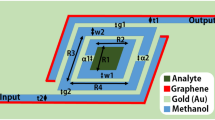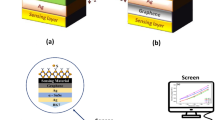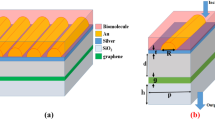Abstract
In this work, a sensitive biosensor is proposed and investigated based on the combinations of graphene-plasmonic nanostructures. The suggested structure is made of different layers of SiO2, gold (Au), and graphene in the formats of U-shaped, split ring, and straight waveguides. Straight waveguides which are connected to the U-shaped waveguides are denoted as the Input, Output1, Output2, and Output3 ports. The incident light-wave would be applied to the Input port and then would be transmitted to the three output ports with different peak wavelengths (considering the specifications of the structure). In the proposed structure, for improving its functionalities (improving the transmission’s peak value and wavelength for biosensing applications), effects of different structural parameters (w1, t1, g1, w2, t2, g2, w3, t3, and g3) and chemical potentials (μc1, μc2, and μc3) are considered. After improving the structure’s transmission spectrum at different output ports (Output1, Output2, and Output3 ports), vital biological element’s concentrations in blood samples (glucose, cholesterol, and creatinine concentrations) would be considered for diagnosis. Finally, considerable sensitivity factors of 1560 nm/RIU “RIU stands for refractive index unit” (for glucose at Output1 port), 2666.6 nm/RIU (for cholesterol at Output2 port), and 1458.3 nm/RIU (for creatinine at Output3 port) are obtained. Also, FWHM and FOM of “13 nm, 120,” “19 nm, 76.75,” and “15 nm, 177.77” are achieved for glucose, creatinine, and cholesterol, respectively. Therefore, the structure can be considered as an appropriate and efficient candidate for biosensing applications in optical integrated circuits.



















Similar content being viewed by others
Data Availability
This declaration is not applicable.
References
Das S, Singh VK (2022) Highly sensitive PCF based plasmonic biosensor for hemoglobin concentration detection. Photonics Nanostructures - Fundam Appl 101040. https://doi.org/10.1016/j.photonics.2022.101040
Chahkoutahi A et al (2022) Sensitive hemoglobin concentration sensor based on graphene-plasmonic nano-structures. Plasmonics 17:423–431. https://doi.org/10.1007/s11468-021-01531-5
Hajshahvaladi L, Kaatuzian H, Danaie M (2022) A high-sensitivity refractive index biosensor based on Si nanorings coupled to plasmonic nanohole arrays for glucose detection in water solution. Opt Commun 502:127421. https://doi.org/10.1016/j.optcom.2021.127421
Kumar A, Kumar A, Srivastava SK (2022) A study on surface plasmon resonance biosensor for the detection of CEA biomarker using 2D materials graphene, Mxene and MoS2. Optik 258:168885. https://doi.org/10.1016/j.ijleo.2022.168885
Hajati Y (2020) Tunable broadband multi resonance graphene terahertz sensor. Opt Mater 101:109725. https://doi.org/10.1016/j.optmat.2020.109725
Emami F et al (2019) Plasmonic multichannel filter based on split ring resonators: application to photothermal therapy. Photonics Nanostructures - Fundam Appl 33:21–28. https://doi.org/10.1016/j.photonics.2018.11.006
Ho YZ et al (2012) Tunable plasmonic resonance arising from broken-symmetric silver nano beads with dielectric cores. J Opt 14:114010. https://doi.org/10.1088/2040-8978/14/11/114010
Chau YF (2009) Surface plasmon effects excited by the dielectric hole in a silver-shell nanospherical pair. Plasmonics 4:253–259. https://doi.org/10.1007/s11468-009-9100-8
Negahdari R, Rafiee E, Emami F (2018) Design and simulation of a novel nano-plasmonic split-ring resonator filter. J Electromagn Waves Appl 32(2018):1925–1938. https://doi.org/10.1080/09205071.2018.1482240
Negahdari R, Rafiee E, Emami F (2019) Design and analysis of the novel plasmonic split ring resonator power splitter appropriate for photonic integrated circuits. J Optoelectron Adv Mater 21(2019):163–170
Wang X et al (2014) Fabrication techniques of graphene nanostructures. Nanofabrication Appl Renew Energy 1–30. https://doi.org/10.1039/9781782623380-00001
Bonaccorso F et al (2012) Production and processing of graphene and 2d crystals. Mater Today 15:564–589
Kasani S et al (2019) A review of 2D and 3D plasmonic nanostructure array patterns: fabrication, light management and sensing applications. Nanophotonics 8:2065–2089. https://doi.org/10.1515/nanoph-2019-0158
Zhang Z et al (2022) Plasmonic sensors based on graphene and graphene hybrid materials. Nano Converg 9. https://doi.org/10.1186/s40580-022-00319-5
Lu H et al (2018) Flexibly tunable high-quality-factor induced transparency in plasmonic systems. Sci Rep 8:1558. https://doi.org/10.1038/s41598-018-19869-y
Panda A et al (2020) Performance analysis of graphene-based surface plasmon resonance biosensor for blood glucose and gas detection. Appl Phys A 126. https://doi.org/10.1007/s00339-020-3328-8
Aly AH, Mohamed D, Mohaseb MA, Abd El-Gawaad NS, Trabelsi Y (2020) Biophotonic sensor for the detection of creatinine concentration in blood serum based on 1D photonic crystal. RSC Adv 10:31765. https://doi.org/10.1039/D0RA05448H
Jin YL, Chen JY, Xu L, Wang PN (2006) Refractive index measurement for biomaterial samples by total internal reflection. Phys Med Biol 51:371–379. https://doi.org/10.1088/0031-9155/51/20/N02
Zhou S, Li X, Zhang J, Yuan H, Hong X, Chen Y (2022) Dual-fiber optic bioprobe system for triglyceride detection using surface plasmon resonance sensing and lipase-immobilized magnetic bead hydrolysis. Biosens Bioelectron 196:113723. https://doi.org/10.1016/j.bios.2021.113723
Rakhshani MR, Mansouri-Birjandi MA (2017) High sensitivity plasmonic refractive index sensing and its application for human blood group identification. Sens Actuators B Chem 249:168–176
Rakhshani MR, Mansouri-Birjandi MA (2017) Utilizing the metallic nano-rods in hexagonal configuration to enhance sensitivity of the plasmonic racetrack resonator in sensing application. Plasmonics 12:999–1006. https://doi.org/10.1007/s11468-016-0351-x
Rakhshani MR, Mansouri-Birjandi MA (2018) A high-sensitivity sensor based on three-dimensional metal–insulator–metal racetrack resonator and application for hemoglobin detection. Photonics Nanostructures - Fundam Appl 32:28–34
Rakhshani MR, Mansouri-Birjandi MA (2018) Engineering hexagonal array of nanoholes for high sensitivity biosensor and application for human blood group detection. IEEE Trans Nanotechnol 17:475–481. https://doi.org/10.1109/TNANO.2018.2811800
Moradiani F et al (2020) Systematic engineering of a nanostructure plasmonic sensing platform for ultrasensitive biomaterial detection. Opt Commun 474:126178
Khani S, Hayati M (2021) An ultra-high sensitive plasmonic refractive index sensor using an elliptical resonator and MIM waveguide. Superlattices Microstruct 156:106970
Khani S, Hayati M (2022) Optical sensing in single-mode filters base on surface plasmon H-shaped cavities. Opt Commun 505:127534
Hossain M, Talukder MA (2021) Gate-controlled graphene surface plasmon resonance glucose sensor. Opt Commun 493:126994. https://doi.org/10.1016/j.optcom.2021.126994
Pedrozo-Peñafiel MJ, Lópes T, Gutiérrez-Beleño LM, Maia Da Costa MEH, Aucelio RQ (2020) Voltammetric determination of creatinine using a gold electrode modified with Nafion mixed with graphene quantum dots-copper. J Electroanal Chem 878:114561. https://doi.org/10.1016/j.jelechem.2020.114561
Abdolmohammad-Zadeh H, Ahmadian F (2021) A fluorescent biosensor based on graphene quantum dots/zirconium-based metal-organic framework nanocomposite as a peroxidase mimic for cholesterol monitoring in human serum. Microchem J 164:106001. https://doi.org/10.1016/j.microc.2021.106001
Shanbhag MM, Shetti NP, Malode SJ, Veerapur RS, Reddy KR (2021) Cholesterol intercalated 2D graphene oxide sheets fabricated sensor for voltammetric analysis of theophylline. Flat Chem 28:100255. https://doi.org/10.1016/j.flatc.2021.100255
Sahraeian S et al (2021) Graphene-metal nanostructure as opto-fluid sensor. Optik 242:166713. https://doi.org/10.1016/j.ijleo.2021.166713
Hanson GW (2008) Dyadic green’s functions and guided surface waves for a surface conductivity model of graphene. J Appl Phys 103. https://doi.org/10.1063/1.2891452
Yu Z, Veronis G, Fan S, Brongersma ML (2008) Gain-induced switching in metal-dielectric-metal plasmonic waveguides. Appl Phys Lett 92(4):041117
Haus HA, Lai Y (1992) Theory of cascaded quarter wave shifted distributed feekback resonators. IEEE J Quantum Electron 28(1):205–213
Zhong ZJ et al (2010) Sharp and asymmetric transmission response in metal-dielectric-metal plasmonic waveguides containing Kerr nonlinear media. Opt Exp 18:79–86. https://doi.org/10.1364/OE.18.000079
Lu H, Liu X, Mao D, Wang L, Gong Y (2010) Tunable band-pass plasmonic waveguide filters with nanodisk resonators. Opt Express 18:17922–17927. https://doi.org/10.1364/OE.18.017922
Chen J, Li Y, Chen Z (2014) Tunable resonances in the plasmonic split-ring resonator. IEEE Photonics J 4800706. https://doi.org/10.1109/JPHOT.2014.2323294
Wang TB, Wen XW, Yin CP, Wang HZ (2009) The transmission characteristics of surface plasmon polaritons in ring resonator. Opt Express 17:24096–24101. https://doi.org/10.1364/OE.17.024096
Xu Z et al (2018) Design of a tunable ultra-broadband terahertz absorber based on multiple layers of graphene ribbons. Nanoscale Res Lett 13. https://doi.org/10.1186/s11671-018-2552-z
Panda A, Pukhrambam PD, Keiser G (2020) Performance analysis of graphene-based surface plasmon resonance biosensor for blood glucose and gas detection. Appl Phys A 16. https://doi.org/10.1007/s00339-020-3328-8
Vafapour Z (2019) Polarization-independent perfect optical metamaterial absorber as a glucose sensor in food industry applications. IEEE Trans Nanobioscience 18:622–627. https://doi.org/10.1109/TNB.2019.2929802
Gandhi S, Awasthi SK, Aly AH (2021) Biophotonic sensor design using a 1D defective annular photonic crystal for the detection of creatinine concentration in blood serum. RSC Adv 11:26655–26665. https://doi.org/10.1039/D1RA04166E
Lu Y, Li H, Qian X, Zheng W, Sun Y, Shi B, Zhang Y (2020) Beta-cyclodextrin based reflective fiber-optic SPR sensor for highly-sensitive detection of cholesterol concentration. Opt Fiber Technol 56:102187. https://doi.org/10.1016/j.yofte.2020.102187
Author information
Authors and Affiliations
Contributions
All authors contributed to the study conception and design. Idea preparation, simulation, and analysis were performed by Esmat Rafiee and Roozbeh Negahdari. The first draft of the manuscript was written by Esmat Rafiee, and all authors commented on previous versions of the manuscript. All authors read and approved the final manuscript.
Corresponding author
Ethics declarations
Ethics Approval
This declaration is not applicable.
Consent to Participate
This declaration is not applicable.
Consent for Publication
This declaration is not applicable.
Competing Interests
The authors declare no competing interests.
Additional information
Publisher's Note
Springer Nature remains neutral with regard to jurisdictional claims in published maps and institutional affiliations.
Rights and permissions
Springer Nature or its licensor (e.g. a society or other partner) holds exclusive rights to this article under a publishing agreement with the author(s) or other rightsholder(s); author self-archiving of the accepted manuscript version of this article is solely governed by the terms of such publishing agreement and applicable law.
About this article
Cite this article
Negahdari, R., Rafiee, E. & Emami, F. Sensitive Biosensors Based on Plasmonic-graphene Nanocombinations for Detection of Biological Elements in Blood Samples. Plasmonics 18, 909–919 (2023). https://doi.org/10.1007/s11468-023-01821-0
Received:
Accepted:
Published:
Issue Date:
DOI: https://doi.org/10.1007/s11468-023-01821-0




